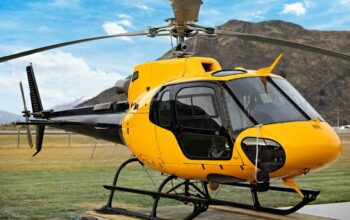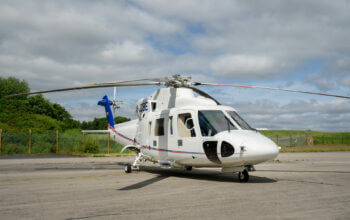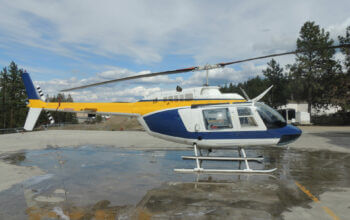Airbus Helicopters’ Racer compound demonstrator continues to make rapid progress in its test campaign, with the aircraft’s flight envelope fully opened up to 165 knots after just four flights.
The latest flight, lasting one hour and 20 minutes, finished in front of a crowd of industry partners, dignitaries, and media, who had gathered at Airbus Helicopters’ headquarters in Marignane, France, for a special event marking the Racer program team’s achievements.
The aircraft only completed its first flight on April 25, and, as Vertical reported last week, recorded 165 knots on just its second flight, which lasted 55 minutes.
Brice Makinadjian, Racer’s chief engineer, said the team was particularly impressed with the aircraft’s stability at such an early stage of flight testing.
“The aircraft was stable without the autopilot,” he said. “The crew is very happy with the behavior of the aircraft [and] with the handling qualities. . . . Without the autopilot, they’ve been able to do this speed without big work for the pilot.”
This was despite poor weather conditions for the second outing, he noted.

The third flight spanned one hour and 40 minutes.
“We did a lot,” said Makinadjian. “We did hover phases, cruise speed, different speeds to calibrate the sensors . . . some climbs, some descents, [and] some turns with high bank angles.”
The latter included a bank of more than 45 degrees at 150 knots, he said, with the aircraft already logging turns at 2g load factors.
“[Through] all those phases we had really no temperatures, no pressures, no vibrations, no loads that are close to limitation — and at the moment [those measurements are] even lower than what could be expected,” said Makinadjian.
The pace of the campaign — roughly one flight a week so far — is currently set by the need to give time for full analysis of each flight’s data before embarking on the next.
“We could make two flights a week, but on the other hand, if you want to analyze properly a flight program of one hour and 40 minutes, and you have to check all the parameters, it’s quite long,” said Makinadjian.
There is no pre-set agenda limiting the plan for each flight, he said. “You just discover how the aircraft is behaving. The crew is in the aircraft, there is the telemetry, and if the telemetry doesn’t show any wrong behavior — and if the crew is not feeling any wrong behavior — then [they] open the domain.”

Hervé Jammayrac, Airbus Helicopters’ chief test pilot, has been in the cockpit for all four flights. The aircraft’s controls, he said, are the same as a traditional helicopter — plus an additional control to increase the pitch of the side rotors for thrust control.
The Racer has the ability to fly in three different modes: a “plane mode” for forward speed, in which the rotor is kept flat with zero pitch and the collective rotors are providing the thrust; a “helicopter mode,” where the lateral rotors have zero pitch and the main rotor is used for climb, and a “hybrid mode,” that uses a combination of the two for climb and descent.
For the first four flights, the Racer has performed hover takeoffs, and then used the lateral rotors to gain forward speed.
Notably, the flight tests have also seen the crew perform the entry and descent into an autorotation, said Jammayrac. In this maneuver, the lateral rotors work like a tail rotor, with the box wing providing the pilots more time to react to engine failure than they would have in a conventional helicopter.
“We can autorotate like any helicopter,” he said. “And actually you have the wings that are lifting a little bit, so you end up with your rate of descent that’s even slower.”

To date, the Racer has been flying without flaps in its lower wings — “a small problem of alignment,” Makinadjian explained — and these are now being installed.
The next step for the test team is simply to “go faster,” he added, as the program team builds towards the Racer’s stated target of 220 knots.
The 165-knot speed achieved to date has been with the Safran Aneto engines about halfway to full power. Given that, could the Racer team surpass not only their 220-knot target, but also the 265-knots record of its compound predecessor, the X3?
“This is not the target,” said Makinadjian. “If we will beat the record, we have the record… this is very good. But I prefer to have a good mission demonstration that would [whet] the appetite of future customers, both in civil and military.”
Those involved with the program are quick to point to the experience gained with the X3 in allowing the Racer to make such rapid progress in its flight test campaign.
“During the development of the Racer, we have taken into account all of what we have learned in the X3,” said Makinadjian. “As a consequence, it is quite normal that we have a more mature aircraft now that we had [that] experience.”
‘Good surprises’ in store
The Racer is equipped with 700 sensors, recording an enormous variety of performance metrics. Makinadjian said the early results indicate that there will be “good surprises in the next few weeks” in terms of the aircraft’s fuel consumption and levels of drag as the aircraft reaches higher speeds.
These two elements, which largely go hand in hand, are key in the seven to eight tonne Racer’s design. The program was funded through the E.U.’s Clean Sky 2 program, which set a target of a 20 percent reduction in fuel consumption compared to similar-sized helicopters.
Key in the design is the use of box wings, which help improve hover efficiency, while providing 50 percent of the lift in forward flight. They also improve the efficiency of the pusher propellers behind them. At the rear of the fuselage, an asymmetrical tail boom helps to counter the torque from the main rotor by directing the airflow from it to one side.

“During the development, [drag reduction] was, for me, the main parameter in terms of decision-making,” said Makinadjian. “The first indications show that we have a very low drag — even a bit lower than what we expected.”
This will be further enhanced next year, when the aircraft will have the “Eco Mode” capability added. This will allow one of the two engines to be put into idle during cruise flight, potentially reducing fuel burn by a further 15 percent.
After this, the aircraft will perform mission demonstrations for potential VIP, air medical, or military customers. These could include a flight from Paris to London (or the equivalent distance) to show how quickly the Racer could fly executives between those two major urban centers, and possibly a hoist rescue mission for parapublic agencies.
While the Racer has been designed to bring the compound architecture developed in the X3 program closer to a final product, Bruno Even, CEO of Airbus Helicopters, said the manufacturer remains open to feedback from potential customers in defining “the right solution” for the market.
“If you ask the customer, ‘Are you interested in speed?’ — the answer will be always ‘yes,’ ” he said. “The question is, ‘What’s the price to pay?’ The price to pay in terms of cost, in terms of reliability, in terms of simplicity, in terms of cost of operation. These [answers] will give you the right configuration. What is very interesting about Racer is we provide the beginning of what could be the right compromise.”
As to whether the first users of a Racer-style platform will be on the civil or military side, Even said current market momentum indicates the military side would be first.
NATO’s Next Generation Rotorcraft Capability (NGRC) program, which aims to develop a new vertical-lift solution to replace member states’ medium-lift multirole helicopter fleets, is a clear potential target. Among the attributes identified for the NGRC is a speed of at least 180 knots, and possibly over 220 knots.
While the NGRC program is still in its very earliest stages, Even said the manufacturer’s efforts with Racer will ensure it is ready to respond if that requirement is confirmed.
“I think it’s important if the day the military customers come to the conclusion that there is a need for speed, what I don’t want is to be in the situation where the European industry has no solution,” he said. “That’s why we prepare ourselves.”









